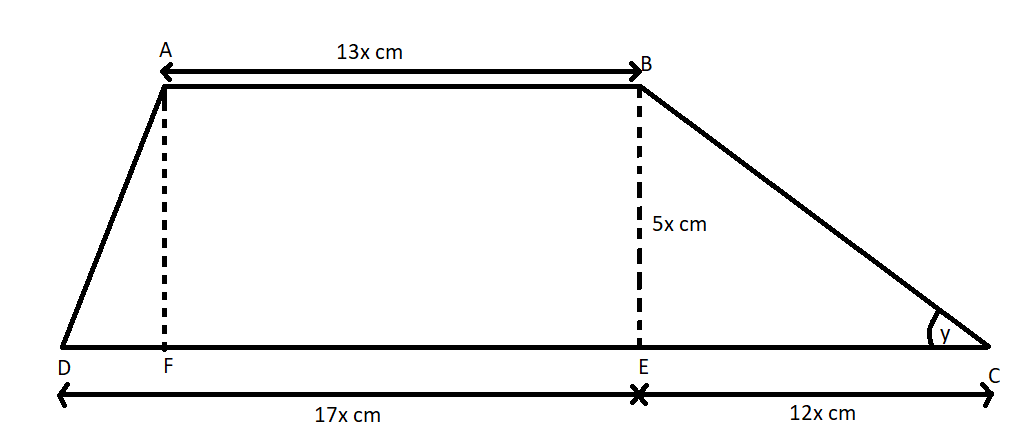
(A) Find the area of the trapezium in terms of x and simplify your answer?
(B) Angle


Answer
487.8k+ views
1 likes
Hint:
Here, we have to use the basic concept of area to find out the area of the trapezium. Firstly we will divide the trapezium into simple shapes like divide it into two triangles and one rectangle. Then we have to find the area of those simple shapes in terms of x and addition of the area of the simple shapes will give us the area of the trapezium. In the second part we have to find out the angle y. So, by simply using the trigonometry formula we will get the value of the angle y.
Complete step by step solution:
ABCD is the given trapezium. So, we have to divide the given trapezium into the simple shapes i.e. two triangles ADF, BCE and one rectangle ABEF.
It is given that
Now we have to find the area of these simple shapes i.e. triangle ADF, BCE and rectangle ABEF.
Therefore, area of triangle ADF
It is given that
Therefore, area of triangle ADF
Now area of the triangle BCE
Therefore, area of the triangle BCE
Now we have to find out the area of the rectangle ABEF
Therefore, area of the rectangle ABEF
Now as the area of the trapezium is the total sum of the area of the basic shapes i.e. two triangles and one rectangle.
Therefore, area of the trapezium
Hence
(B) In this we have to find out the angle y in the trapezium. So we have to use the trigonometry formula to find out the angle y.
So, in right triangle BCE right angle at E, we know that
Therefore,
Hence,
Note:
Right Triangle is a triangle where one of its interior angles is a right angle (90 degrees). The relation between the sides and angles of a right triangle is the basis for trigonometry. The side opposite the right angle is called the hypotenuse. The sides adjacent to the right angle are called legs.
Pythagoras theorem stated that in a right angled triangle the square of the long side is equal to the sum of the squares of the other two sides.
We have to remember all the trigonometry formulas
Here, we have to use the basic concept of area to find out the area of the trapezium. Firstly we will divide the trapezium into simple shapes like divide it into two triangles and one rectangle. Then we have to find the area of those simple shapes in terms of x and addition of the area of the simple shapes will give us the area of the trapezium. In the second part we have to find out the angle y. So, by simply using the trigonometry formula we will get the value of the angle y.
Complete step by step solution:
ABCD is the given trapezium. So, we have to divide the given trapezium into the simple shapes i.e. two triangles ADF, BCE and one rectangle ABEF.
It is given that
Now we have to find the area of these simple shapes i.e. triangle ADF, BCE and rectangle ABEF.
Therefore, area of triangle ADF
It is given that
Therefore, area of triangle ADF
Now area of the triangle BCE
Therefore, area of the triangle BCE
Now we have to find out the area of the rectangle ABEF
Therefore, area of the rectangle ABEF
Now as the area of the trapezium is the total sum of the area of the basic shapes i.e. two triangles and one rectangle.
Therefore, area of the trapezium
Hence
(B) In this we have to find out the angle y in the trapezium. So we have to use the trigonometry formula to find out the angle y.
So, in right triangle BCE right angle at E, we know that
Therefore,
Hence,
Note:
Right Triangle is a triangle where one of its interior angles is a right angle (90 degrees). The relation between the sides and angles of a right triangle is the basis for trigonometry. The side opposite the right angle is called the hypotenuse. The sides adjacent to the right angle are called legs.
Pythagoras theorem stated that in a right angled triangle the square of the long side is equal to the sum of the squares of the other two sides.
We have to remember all the trigonometry formulas
Latest Vedantu courses for you
Grade 10 | CBSE | SCHOOL | English
Vedantu 10 CBSE Pro Course - (2025-26)
School Full course for CBSE students
₹37,300 per year
Recently Updated Pages
Master Class 10 General Knowledge: Engaging Questions & Answers for Success

Master Class 10 Computer Science: Engaging Questions & Answers for Success

Master Class 10 Science: Engaging Questions & Answers for Success

Master Class 10 Social Science: Engaging Questions & Answers for Success

Master Class 10 Maths: Engaging Questions & Answers for Success

Master Class 10 English: Engaging Questions & Answers for Success

Trending doubts
A boat goes 24 km upstream and 28 km downstream in class 10 maths CBSE

Why is there a time difference of about 5 hours between class 10 social science CBSE

The British separated Burma Myanmar from India in 1935 class 10 social science CBSE

The Equation xxx + 2 is Satisfied when x is Equal to Class 10 Maths

Chandigarh is the capital of A Punjab B Haryana C Punjab class 10 social science CBSE

Change the following sentences into negative and interrogative class 10 english CBSE




